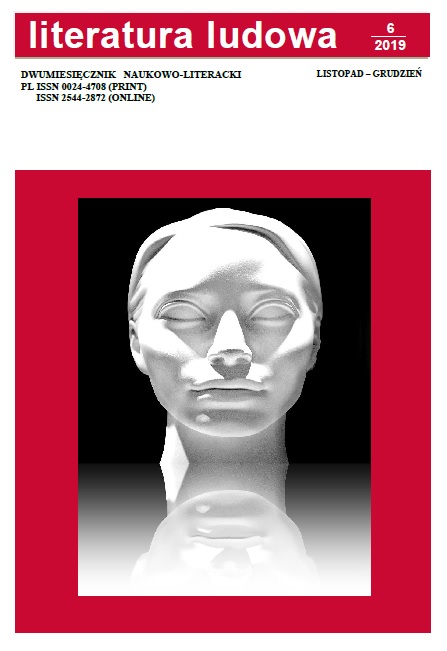A Damsel in Distress, a Sexual Slave and a Femme Fatale: Mechanisms of Creating a Female Character as an Erotic Object in Andrzej Ziemiański’s Novel Achaja
DOI:
https://doi.org/10.12775/LL.6.2019.004Keywords
fantasy, Polish literature, popular literature, erotism, sexuality, erotic object, Andrzej ZiemiańskiAbstract
This article presents an analysis of methods used by Andrzej Ziemiański in his novel Achaja to create a female character. The main character of the novel is the eponymous Achaja, a princess of the fictional kingdom called Troy. Although she is presented as a strong heroin dealing with all sorts of adversities, in fact she can’t make decisions for herself. The article presents three stereotypical figures of femininity reflected in the main character at various stages of the novel: a damsel in distress, a sexual slave and a femme fatale. The analysis shows that the protagonist is defined by her sexual attractiveness and that she is created as an erotic object.
References
BATAILLE, G. (2007). Erotyzm (przeł. M. Ochab). Gdańsk: słowo/obraz terytoria.
BAUMAN, Z. (1995). Ciało i przemoc w obliczu ponowoczesności. Toruń: Uniwersytet Mikołaja Kopernika.
GORER, G. (1979). Pornografia śmierci (przeł. I. Sieradzki). „Teksty. Teoria, krytyka, interpretacja”, 3 (45), 197–203.
KACZOR, K. (2014). Bogactwo polskich światów fantasy. Od braku nadziei ku eukatastrophe. W: S. J. Konefał (red.), Anatomia Wyobraźni (s. 181–198). Gdańsk: Gdański Klub Fantastyki.
KACZOR, K. (2017). Z „getta” do mainstreamu. Polskie pole literackie fantasy (1982–2012). Kraków: Universitas.
KLEMENTOWSKI, R. (2005). Nasza mała stabilizacja. Polska fantastyka na początku trzeciego tysiąclecia. „Czas Fantastyki”, 2, 7–13.
KLIMCZYK, W. (2008). Erotyzm ponowoczesny. Kraków: Universitas.
KOPYRA T., ZIEMIAŃSKI A. (2004). Wywiad. „Fahrenheit”, 34. Pozyskano z: http://www.fahrenheit.net.pl/archiwum/f34/14.html.
KOZIOŁEK, R. (2009). Ciała Sienkiewicza. Studia o płci i przemocy. Katowice: Wydawnictwo Uniwersytetu Śląskiego.
KUROWSKA, K., ZIEMIAŃSKI A. (2013). Czy Polacy pasują do fantastyki? Pozyskano z: http://fan-dom.pl/2013/02/28/luty-z-andrzejem-ziemianskim-czy-polacy-pasuja-do-fantastyki/.
MAZURKIEWICZ, A. (2007). Współczesna polska literatura fantasy: stan obecny, szanse i zagrożenia. W: J. Deszcz-Tryhubczak, M. Oziewicz (red.), Rozważając fantasy. Etyczne, dydaktyczne i terapeutyczne aspekty literatury i filmu fantasy (s. 11–20). Wrocław: Oficyna Wydawnicza Atut.
NIJAKOWSKI, L. (2010). Pornografia. Historia, znaczenie, gatunki. Warszawa: Wydawnictwo Iskry.
PŁOSZAJ, J. (2016). Powabne wybranki Mordimera Madderdina. Kreacje i role postaci kobiecych w cyklu inkwizytorskim Jacka Piekary na tle przygodowego schematu fabularnego. W: K. Jewtuch, K. Kowalczyk, J. Płoszaj (red.), Kobieca strona popkultury. Wrocław: Stowarzyszenie Badaczy Popkultury i Edukacji Popkulturowej „Trickster” (s. 33–49). Pozyskano z: http://tricksterzy.pl/download/kobieca-strona-popkultury/.
SINKO, Z. (1961). Powieść angielska osiemnastego wieku a powieść polska lat 1764–1830. Warszawa: Państwowy Instytut Wydawniczy.
SZKLARSKI, M. (2004). Naiwne okrucieństwo. „Informator Gdańskiego Klubu Fantastyki”, 181, 18–19.
TKACZ, M. (2012). Baśnie zbyt prawdziwe. Trzydzieści lat fantasy w Polsce. Gdańsk: Gdański Klub Fantastyki.
UNIŁOWSKI, K. (2003). Wojowniczki, czarodziejki i kochanki. „Opcje”, 3 (50), 20–28.
ZIEMIAŃSKI, A. (2011). Achaja, t. 1. Lublin: Fabryka Słów.
ZIEMIAŃSKI, A. (2003). Achaja, t. 2, Lublin: Fabryka Słów.
ZIEMIAŃSKI, A. (2004). Achaja, t. 3, Lublin: Fabryka Słów.
Downloads
Published
How to Cite
Issue
Section
License
1. The authors give the publisher (Polish Ethnological Society) non-exclusive license to use the work in the following fields:a) recording of a Work / subject of a related copyright;
b) reproduction (multiplication) Work / subject of a related copyright in print and digital technique (ebook, audiobook);
c) marketing of units of reproduced Work / subject of a related copyright;
d) introduction of Work / object of related copyright to computer memory;
e) dissemination of the work in an electronic version in the formula of open access under the Creative Commons license (CC BY - ND 3.0).
2. The authors give the publisher the license free of charge.
3. The use of the work by publisher in the above mentioned aspects is not limited in time, quantitatively nor territorially.
Stats
Number of views and downloads: 793
Number of citations: 0



